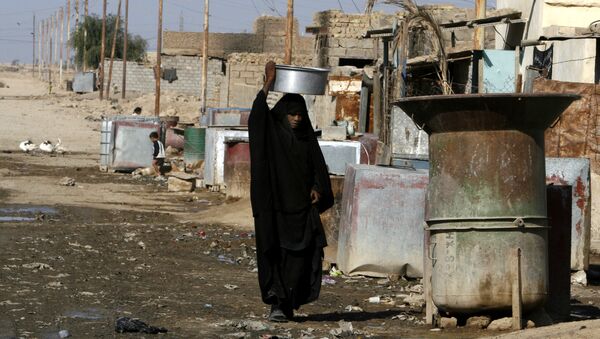The figure has jumped $57 trln since the end of 2007, just before the full-scale onset of the global financial crisis and the subsequent excessive and not-always-necessary use of monetary stimulus by national governments. Vicious practices of liquidity injections into inefficient, bound-to-fail enterprises (these bailouts within the financial sector and outside it have become notorious in some cases, as with Wells Fargo or General Motors), money printing and the overall devaluing of investment vehicles across the planet triggered an unprecedented depreciation of labor and human effort in general, as wages have been diminishing in conjunction with most currencies' effective FX rate.
The high levels of social and political apathy and depression we witness today in different parts of the world are largely due to the irresponsible accumulation of debt burdens by both public and private entities, the ultimate effect of which has been a sharp devaluation in economically viable human diligence.
The human race is far beneath contempt these days as roughly $200 trln in debt is enough money to buy pretty much everything on Earth. However, humanity is not indebted to a well-to-do alien civilization, the cumulative global debt burden is a complicated puzzle of interwoven mutual – and exclusively sublunary – obligations. National governments owe to their central banks, other nations and other nations’ central banks; households and businesses owe to commercial banks, which in turn are in debt to central banks or other commercial banks or both.
Governments’ IOUs (usually sovereign bonds) are freely traded in financial markets, and you might even find the ever-powerful Uncle Sam in debt to you personally if you manage to put together enough dough to buy one of those precious US Treasuries.
When you go to buy food or clothes, you do not actually pay the actual market-determined price, even including the transportation expenses and commercial interest. The greatest volume of manufactured goods is produced in places with the cheapest toil, sometimes characterized by child and slave labor, out of dirt-cheap commodities, meaning the prime cost of consumer goods approaches zero. What you pay for are branding and advertising expenses, packaging and marketing, and the shop’s interior with consumer-friendly natural lighting.
Yes, we can afford it, and this is how we owe three times more than we earn. Mind you – this figure is the global average, and we are not talking about the differences in well-being between the developed nations and the third world!
The United States has often been described as the world’s greatest debtor, with the rest of the free world following, competing in terms of external and domestic borrowing, as well as left-wing experiments and weird monetary policies during the last couple decades, most notably since the recent recession.
However, the risks and threats coming from the debt-driven growth model practiced by the likes of the US, Japan, the UK, France or Germany (and in other countries of the Eurozone which haven't fallen from grace), are effectively offset by the boisterous yet sustainable functioning of these nations’ financial sectors and often more prudent than not central bank policies, along with relatively open public discussion and predictable macromanagement.
At this point, greater threats to global growth are posed by the risky debt accumulation practices of the biggest economies in the third world, mainly non-transparent and unaccountable mainland China. Since 2007, China has added about $20.7 trln in external debt, and its overall debt burden has reached 28.2 trln, or 282% of its GDP. China is followed by Russia ($600 bln, 23% of GDP), Brazil ($428.3 bln, 15%), Turkey ($387 bln, 48%) and India ($456 bln, 22.795%).
The growing imbalances in international trade are the cornerstone, from which the risks of a series of economic collapse may soon stem throughout the developing world. As the US is slowly but surely abandoning its QE program, resulting in a stronger dollar, a reduced pace of debt accumulation, decreased imports and more jobs at home, the third world is facing a multi-dimensional challenge.
First, the developed world has recently been importing less, relying more on local production, reuse and recycling, as well as capitalizing on the benefits of advances in technology (shale oil being the prime example of the latter). This implies that the rest of world is losing money in export revenues.
Second, the US dollar, the most widely used instrument of liquidity internationally, is appreciating, making it harder for the developing nations to conduct trade operations with the first world and in between themselves as well.
Third, as international companies seek either cheaper labor or a better business environment, the offshoring trend that dominated the 2000s has now partially reversed with industries going either back to the US or Europe, or proceeding past even further off the beaten path; Samsung is investing billions in smartphone production in Vietnam, according to Reuters, "Mobile phones and accessories became Vietnam's biggest cash earner [in 2013], taking over textiles."
"It is like a balloon. If you squeeze debt in one place, it pops up somewhere else in the system," the report's authors say. Now, why are these nations in risk? Canada is a resource-based, overtly monopolized economy, the Netherlands relies on oil production and refining, which is a less profitable business now. Australia is an agricultural economy which hopes to benefit from the US-launched Trans-Pacific Partnership, which would allow Aussie meat to invade Japan and the US and a lot of other nations of the Pacific Rim.
Sweden is gravely indebted due to their excessive left-wing experimentation, while Malaysia is cursed with oil, and Thailand has been politically unstable, weighing on the nation's economy.
The world's biggest banks have recently taken steps to deleverage their debt burden. The Western civilization has been popularizing the anti-consumerist anti-borrowing "hipster" minimalist lifestyles. The debt burden is manageable at this point, and the pace of the US borrowing is no longer a cause for excessive worry despite President Obama's leftist leanings. However, the recent monetary easing undertaken by the European and Japanese Central Banks and the excessive shadow banking and property sales in mainland China are prompting concern.
A new Fannie May and Freddie Mac might emerge in China, but this time they will be non-transparent, meaning the depth of their fall will be unknown. They will be backed by an obscure government and a weak export-based developing economy. An economic crash in China, or any other nation similar to it in a political and economic sense, would produce, above other spillovers and risks, the most significant global challenge, a financial superbacteria of sorts – the highest-seen degree of uncertainly, fueled by the unpredictable and unaccountable nature of the government in such a nation.
Would they accuse an "external enemy" of their economic collapse and start a nuclear war or try to overcome the turmoil by adjusting and reforming their economy? Would they speed up borrowing to boost their liquidity or would they default on their existing debts?
Apart from the globally-destabilizing uncertainty produced by the volatile situation in the biggest third-world economies, the ultimate result of the debt turbulence in the developing nations would be their division into two groups.
The first group of countries consists of those which are slated to eventually join the club of developed nations by successfully reforming and diversifying their economies via political progress, as well as the provision of more transparency, accountability and trust.
The second group will remain mired in backwardness and corruption, and the competitive edge of such nations will be dirt-cheap labor and lawlessness, which allows for large-scale criminal schemes to be freely exercised. These nations will become safe havens for drug trafficking, shadow banking, the arms trade, cyber-crime, illicit nuclear deals and other activities which warrant international concern.
The fact is, as the US is growing increasingly isolationist, it is up to the national governments in the developed world to decide which way to proceed through the turbulence they are facing. One thing is known for sure: there won't be another Washington-led global bailout like those that happened in 1997 and 2008.





